Vehicle chips: the foundation of software-defined cars
Software is rapidly reshaping the automotive industry: the four disruptive trends of the industry — automated driving, connectivity, electrification, and sharing — all heavily rely on software. Every OEM, supplier, and start-up company in the industry wishes to take the initiative on this new software-driven value chain.
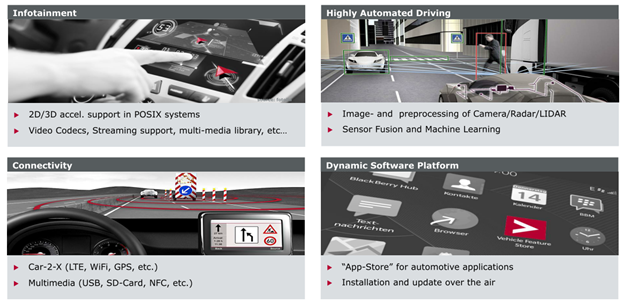
As the complexity of vehicle functions increases, the amount and complexity of software code in software-defined cars is growing rapidly. The amount of code in high-end cars is far greater than that of PC and smartphone operating systems. According to one organization, the code size of the common Android operating system for smartphones is 130,000 lines, while the code size of Windows Vista for PCs is 50 million lines. The code size of a high-end car can reach 100 million lines. Moreover, NXP’s website predicts that the amount of code in cars is expected to increase exponentially from 2015 to 2025, with a compound annual growth rate of about 21%.

As the saying goes, “a good horse must have a good saddle.” Although our vehicle functions are becoming more and more abundant, how do we ensure the safe, efficient, and reliable operation of the software? Undoubtedly, we must rely on increasingly powerful hardware, and the core of the hardware is vehicle chips.

In 2021, people in the automotive industry, whether in Tier 1 or OEM, clearly feel the pressure brought by the shortage of vehicle chips. The global “chip shortage” for automobiles has become the current situation of the industry. At the same time, due to the impact of the pandemic, global consumer demand for mobile electronic device chips is even higher, which also exacerbates the “chip shortage” in the automotive industry. With the shortage of chips and their importance to smart cars, chips have become a competitive bargaining chip for car companies.
This time, global automakers have been “choked” by “chips,” and major car companies have also started to pay more attention to the issue of chip supply security. Due to the continuing shortage of chips, major automakers such as BMW, Daimler, and Honda have announced new shutdown plans.
Therefore, major car companies also intend to jointly develop and research vehicle chips through direct or indirect cooperation with chip manufacturers. But before that, most car companies still have to bear the “chip shortage.” Daimler revealed that its production in the second quarter would decline due to the chip shortage. It is expected that the global chip shortage situation may ease by this summer, but it may not be completely resolved until 2022.## Introduction to Automotive Chips
For a long time, the development of automotive electronics has been much slower than that of the IT industry. Smart devices have changed our way of life in the past few years, while automotive electronics have not kept up with the pace of digital life. There are two important differences between consumer electronics and automotive electronics: the stringent requirements for safety and reliability of automotive electronics cannot be compared with those of consumer electronics, as automotive electronics are related to personal safety, and any negligence can cause serious quality problems and endanger the safety of passengers’ lives and property. Therefore, automotive electronics cannot pursue new trends like the IT industry does all day long but should prioritize safety and reliability.
In many years of the past, the functionality of the entire vehicle was not as complex as it is today. Under the premise of meeting the requirements of functionality, safety and reliability, 8-bit, 16-bit, and 32-bit single-core processors were sufficient.
However, in recent years, the unstoppable trend of the new four modernizations of the automotive industry has brought profound changes to automotive electronics. The increasing demand for the functionality of the entire vehicle and the combination of IT technology have made the processing power of single-core limited-capacity processors unable to meet the current and future requirements. The automotive industry is increasingly in need of more powerful chips to support it.
Chips are a general term for semiconductor component products, also known as integrated circuits (ICs). Automotive chips are mainly divided into three categories: functional chips (MCUs, Microcontroller Units), power semiconductors, and sensors.
Functional chips: mainly refer to processors and controller chips. The vehicle control system mainly includes several major parts such as the vehicle body electronic system, the vehicle motion system, the powertrain system, the information entertainment system, and the automatic driving system. There are many sub-function items under these systems, and each sub-function item has a controller, which includes a functional chip.
The autonomous driving chip is essentially a functional chip and is a high-performance chip that has emerged with the development of intelligent vehicles. At present, the commercially available autonomous driving chips are basically at the advanced driving assistance system stage, which can achieve L1-L2 level assisted driving, and some claim to achieve L3-level functions. Autonomous driving chips for L4-L5 level fully automatic driving are still some distance away from large-scale commercial use.
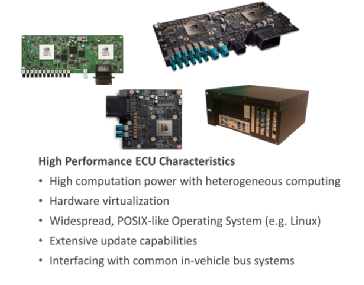
The autonomous driving chip is becoming a new battleground for many parties. Consumer electronics chip giants such as Intel, Nvidia, Qualcomm, and AMD, innovative companies such as Horizon and Black Sesame, technology companies such as Huawei and Baidu, and automakers represented by Tesla are all making layout plans.The computing power and energy efficiency ratio are the main evaluation criteria for autonomous driving chips – L1-L2 level requires a chip computing power of less than 10 TOPS, L3 level requires 30-60 TOPS, L4 level requires a chip computing power greater than 100 TOPS, and L5 level requires 500-1000 TOPS.
Power semiconductors: mainly responsible for power conversion, used in power supplies and interfaces, such as IGBT power chips used in electric vehicles and metal-oxide-semiconductor field-effect transistors (MOSFETs) that can be widely used in both analog and digital circuits.
Sensors: mainly used in various radars, safety airbags, tire pressure detection, etc.
In the field of automotive electronics, chip suppliers for autonomous driving include Infineon, NXP, ST, Renesas, etc.
Multi-core support for high-performance chips
Firstly, automotive software increasingly requires support for multi-core processors due to the following reasons:
-
The architecture and functions of automotive electronics are becoming increasingly complex and require hardware with stronger computing power to support increasingly complex software features. With the addition of ADAS, autonomous driving and other application scenarios, as well as changes in the E/E architecture of central computers in the future, the demand for multi-core systems will become more apparent.
-
Parallel computing needs: for example, the output calculation of certain functions requires multiple input factors to be executed in the same time slot and inputted into the function module at the same time.
-
Serial computing needs of multiple tasks in the same time slot: for example, multiple functions need to be executed in the same time slot in a serial manner.
-
Demand for system response capability: for example, for those interrupt processes that require extremely high time requirements, they need to be run separately on one core, while periodic tasks are run on another core to improve the response capability of the entire system.
Multi-core processors are mainly divided into two categories according to their kernel architecture: homogeneous and heterogeneous processors.Heterogeneous Multi-core Architecture: An MCU is composed of multiple cores with different architectures, such as NXP LPC4370 (one Arm® Cortex®-M4 and two Cortex®- M0). In a heterogeneous multi-core processor, a high-performance main core is usually paired with a low-performance auxiliary core (the main core is used to execute batch application processing), and the smaller core is referred to as a coprocessor (mainly used to process some less complex operations, such as continuously sending data on I/O; therefore, even if there is a second core, it is called a coprocessor because its role is to support or supplement the main core). In addition, ARM core architecture automotive chips will be increasingly used in future intelligent cabins, intelligent driving, and other fields. Here is an S32V chip from NXP for visual processing:
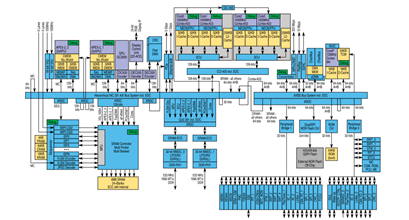
Homogeneous Multi-core Architecture: Multiple cores with similar architectures are used in an MCU. Multiple cores can run the same code and applications synchronously or asynchronously. Homogeneous multi-core architecture has a lockstep mode, which is the key to ensuring the safety of applications. In recent years, many automotive chip manufacturers have launched multi-core processors. The following are examples of some mainstream chips used in automotive powertrain:
1. Infineon
Infineon AURIX TC27x series processors have three 32-bit TriCore architecture cores, two of which support lockstep (1.6P and 1.6E) and one is non-lockstep (1.6P). The so-called 1.6P is a superscalar core, and generally, TC 1.6P core performance is 10-20% higher than TC 1.6E.
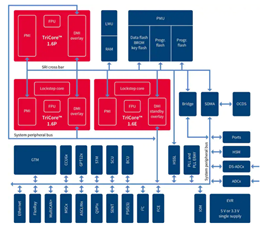
This processor supports the application fields of chassis safety and powertrain.
2. NXP
The NXP MPC5777M multi-core processor has three 32-bit Tri-Core cores, including two 300 MHz computing cores e200z7 (one lockstep core and one non-lockstep core) and one 200 MHz peripheral core e200z4.
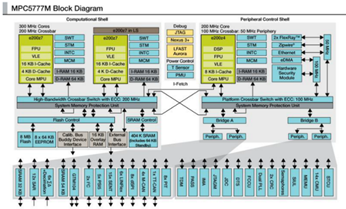 In short, major automotive electronic chip suppliers all have their own multi-core system solutions, which we won’t delve into here. Domain controllers, which have been increasingly in the spotlight in recent years, are intended to integrate the functionality of multiple controllers into one hardware device, simplifying the E/E architecture of the whole vehicle and reducing costs. Below is an application example of a domain controller:
In short, major automotive electronic chip suppliers all have their own multi-core system solutions, which we won’t delve into here. Domain controllers, which have been increasingly in the spotlight in recent years, are intended to integrate the functionality of multiple controllers into one hardware device, simplifying the E/E architecture of the whole vehicle and reducing costs. Below is an application example of a domain controller:
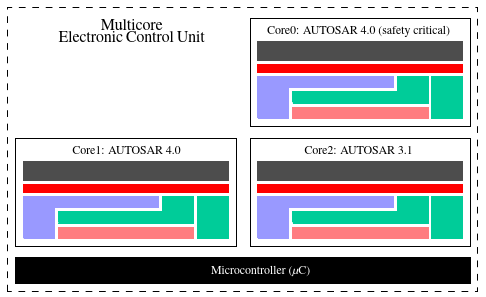
The above diagram shows ICNexus Technology’s multi-core heterogeneous computing architecture, which integrates different structures, including ARM Cortex-A55, PowerVR GPU, Cortex-R5, CV engine, packet processing engine, Slim AI engine, and voice engine, all on a single chip, achieving efficient communication with minimal loss.
Furthermore, ICNexus Technology’s X9 solution provides a single-chip full lineup solution for intelligent cabins, which can deliver a ten-screen cabin driving experience by integrating a variety of functions, including central entertainment and navigation control, full LCD virtual instrument panel, voice recognition, passenger entertainment, independent rear-seat entertainment, head-up display (HUD), 360-degree panorama view, and more. Its powerful performance is visibly demonstrated.
High-performance chips and their support for information security
Safety is an eternal topic in every field, and the automotive industry is no exception. In recent years, automotive safety has drawn increasing attention from users and developers alike. Security is a multi-faceted issue, with users possibly concerned about privacy and personal safety when using the vehicle telematics system, enabling ACC and other driving assistance features, etc. From the perspective of software developers, they will focus on and consider the reliability and security of the entire E/E architecture, hardware, and software, such as the EMC and unexpected failures of hardware, and the security of internal and external communication within the controller, among others. Each security factor is an important component of the system objective, only to ensure the reliability and safety of the whole vehicle, thereby protecting the information and personal safety of the users.With the growing complexity of software and the steady increase in the number of in-vehicle systems and sensors, the communication within the vehicle systems is growing exponentially and password protection must be strengthened. This protection can be achieved through the classic AUTomotive Open System ARchitecture (AUTOSAR). Even in resource-constrained situations, installing appropriate firmware on hardware security module (HSM) is still an everlasting technology that can be used to verify the system passwords. The hardware security module (HSM) is an independent microcontroller connected by a firewall to the main system bus of the host system. HSMs typically have their own protected memory (RAM), a dedicated flash memory area for program code and data, and peripheral devices such as timers, hardware accelerators for certain cryptographic algorithms, or generators for true random numbers. It can access all the hardware of the host. It implements system security, authenticated boot, or host monitoring at runtime. A dedicated data flash can be used to store the keys, and the host system cannot access it at will. This means that the host can request that HSM performs encryption operations without the key leaving HMS. However, the special advantage of HSM is that it is programmable. As an independent microcontroller, HSM can run any program code that is optimized for the current use case. This makes its security requirements higher than a simple coprocessor. Managing access to on-chip peripherals and communication encryption and decryption outside the chip through HSM will improve information security.
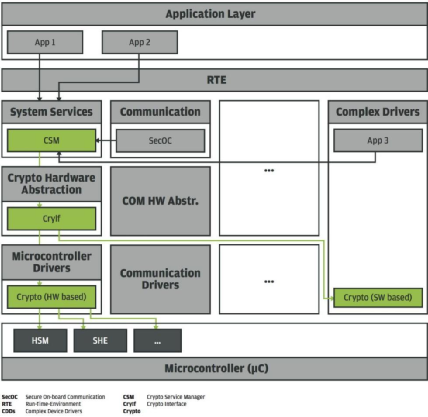
Chip China Technology’s chips are built with independent HSM, which have independent power supplies, clocks, and peripheral interfaces, designed to the highest functional safety standards in the system, which can be used as a series of security control systems.
High-performance chips support for functional safety and development challenges
The application of high-performance multicore chips is not only to improve computing power but also to decompose different ASIL levels through multi-core, however, achieving functional safety defined in ISO26262 in a multi-core system is not easy. To achieve a certain functional safety design goal on a multi-core system will have a certain impact on both hardware and software.
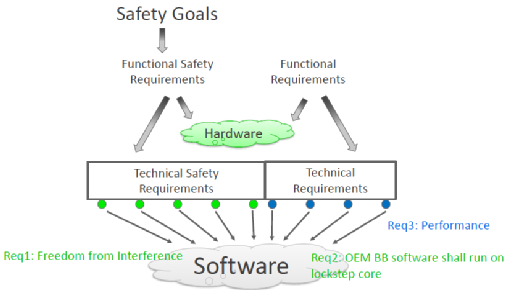
On the hardware side, it may be the lockstep concept of the multicore processor: in lockstep mode, two cores execute the same code separately, and an independent comparator compares the calculation results of the two cores and generates a trap in case of differences. The subsequent processing depends on the hardware conditions and safety architecture of the ECU, where the hardware design must ensure that the ECU remains in a safe state after the trap occurs (the addition of lockstep cores is not a multi-core architecture that improves computing power but a multi-core mechanism that ensures system safety, personal understanding).According to the parallelism and relevant security architecture of the software, the software developers assign upper-layer software modules to the OS Application defined in AUTOSAR in the automotive industry. This allocation process corresponds to the “partition” defined in ISO26262, and this process ensures that the ECU will not cause mutual interference in the internal areas during runtime.
In multi-core ECUs, OS Applications are assigned to different processor cores. From the perspective of developers, the main purpose of partitioning is not program parallelism or program security, but to ensure that OS applications do not interfere with each other. Therefore, it is particularly necessary to introduce runtime monitoring and avoid tampering with security-related memory contents.
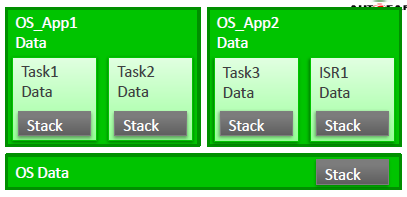
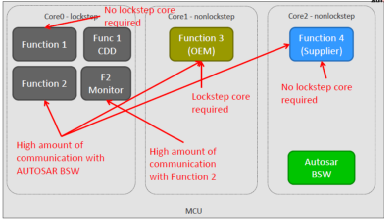
In summary, high-reliability and high-performance automotive chips provide a foundation for complex automotive software development and application while providing rich peripherals. Although foreign companies monopolized the core technology of chips for a long time, many domestic enterprises, such as Horizon Robotics and Horizon Technologies, have achieved remarkable innovation and good market performance in research and development. Therefore, we have sufficient reason to believe that the evolution of intelligentization will be faster and more exciting than expected.
References: Tiger Securities, McKinsey, Vector, EB, and other materials.
This article is a translation by ChatGPT of a Chinese report from 42HOW. If you have any questions about it, please email bd@42how.com.